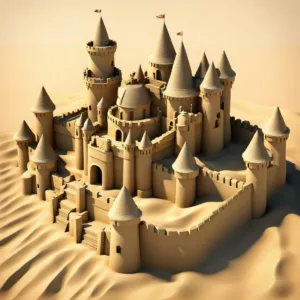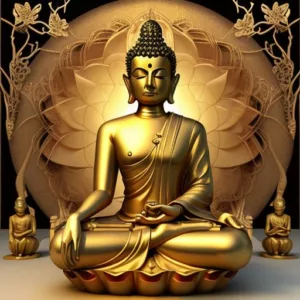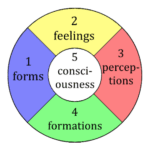
Buddhism Statues are all around the world, but concentrated in the East of course.
Secrets of Meditation for Anxiety
Like millions of people, you may have suffered from anxiety for years. Meditation, yoga, peaceful music – it never works. It takes too long, and it’s not stable. Why? Because peace is treated as a cause for freedom, but it’s not – it’s the result. The cause to free yourself from anxiety is completely different.
Click now to Overcome Anxiety for good.
Table of Contents
Well-Known Buddhism Statues
| Statue Name | Location | Description | Significance |
|---|---|---|---|
| Leshan Giant Buddhism statues | Leshan, China | 71-meter tall rock carving of a seated Buddha | Largest cliff carving of a Buddha in the world. |
| Spring Temple Buddha | Lushan County, China | 108-meter tall bronze statue overlooking the Yellow River | One of the tallest statues in the world. |
| Tian Tan Buddha (Big Buddha) | Ngong Ping, Lantau Island, Hong Kong | 34-meter tall bronze statue overlooking the South China Sea | Popular tourist destination and a symbol of peace and harmony. |
| Borobudur | Magelang Regency, Indonesia | 9th-century Mahayana Buddhist temple with six square terraces adorned with 2,500 Buddhism statues. | One of the largest Buddhist temples in the world. |
| Buddhas of Bamiyan (destroyed) | Bamiyan Valley, Afghanistan | Two colossal 6th-century stone statues of standing Buddhas | Largest examples of standing Buddha carvings before their destruction in 2001. |
| Emerald Buddha | Wat Phra Kaew, Bangkok, Thailand | Seated jade Buddha statue believed to have been created in the 4th century BCE. | One of the most revered Buddhism statues in Thailand. |
| Dordenma Buddha Statue | Thimphu, Bhutan | Giant bronze Shakyamuni Buddha statue overlooking the city | Represents peace and enlightenment. |
| Great Buddha of Kamakura | Kamakura, Japan | 13.35-meter tall bronze statue dating back to the 12th century. | One of the most iconic landmarks in Japan. |
| Ushiku Daibutsu | Ushiku, Ibaraki Prefecture, Japan | 120-meter tall bronze statue of Amitabha Buddha | Tallest bronze statue in the world. |
| Avukana Buddha Statue | Avukana, Sri Lanka | 12-meter tall rock carving of a standing Buddha | One of the oldest and largest Buddha statues in Sri Lanka. |
How to meditate like a yogi
and enter profound samadhi
Buddhism Statues Meaning
Buddhist statues are much more than impressive works of art or tourist attractions. They serve several important purposes within Buddhist traditions:
- Representations of the Buddha: First and foremost, Buddhism statues depict the historical Buddha, Siddhartha Gautama, serving as a constant reminder of his teachings and path to enlightenment.
- Inspirational Symbols: The statues embody the qualities of a Buddha – peace, wisdom, compassion – inspiring practitioners to cultivate these qualities within themselves.
- Teaching Aids: The postures, gestures (mudras), and even clothing of Buddhism statues often hold specific meanings that convey aspects of the Buddha’s teachings or significant events in his life.
- Objects of Devotion: For many Buddhists, the statues serve as objects of devotion, allowing them to focus their minds and cultivate feelings of reverence and gratitude.
- Meditation Aids: The serene and focused expression of the Buddha statues can act as an anchor for meditation practice, helping practitioners cultivate inner stillness and concentration.
- Merit-Making: In some traditions, the act of building, donating to, or caring for Buddha statues is seen as a way to create merit, a positive karmic force that can lead to future happiness.
Specific Mudras (Hand Gestures):
The hand gestures (mudras) of Buddha statues are particularly rich in symbolism. Some common examples include:
- Bhumisparsha Mudra (Earth Witness): Right hand touching the ground, symbolizing the Buddha calling upon the earth to witness his enlightenment.
- Dhyana Mudra (Meditation Mudra): Hands resting in lap, palms facing upwards, symbolizing meditation and tranquility.
- Varada Mudra (Gift-Giving Mudra): Right hand raised with palm outward, signifying generosity and compassion.
- Abhaya Mudra (Fearlessness Mudra): Right hand raised with palm outward, fingers pointing upwards, representing protection and dispelling fear.
Understanding the mudras can add another layer of meaning to appreciating Buddhist statues.
In Conclusion:
Buddhist statues are powerful tools that serve as constant reminders of the Buddha’s teachings, inspire practitioners, and offer a focus for meditation and devotion. Their presence helps cultivate a more mindful and compassionate way of being.



Tibetan Buddhism statues
are known for their unique blend of artistic styles and deep spiritual significance. Here are some of the most well-known Buddhist statues found in Tibet:

Jokhang Temple Statues: Located in Lhasa, the Jokhang Temple enshrines two Buddhism statues considered to be the most مقدس (mengjie – sacred) Buddhist images in Tibet.
- The first is the Jowo Shakyamuni statue, believed to have been brought to Tibet by Princess Bhrikuti in the 7th century. Opens in a new window smarthistory.org
- The second is the statue of Rinpoche (Rinpoche – precious one) Vrijnatakra, said to have been brought to Tibet by Princess Wencheng during the same era.

Tawang Monastery:This prominent monastery in Arunachal Pradesh, India, is home to the Druk Sangpo Guru Rinpoche statue. Standing 18 meters tall, it is the largest indoor Buddha statue in India. Opens in a new window en.wikipedia.org
- Ramochê Temple: This temple houses the colossal Shakyamuni Buddha statue, standing at an impressive 38 meters tall. Construction began in the 15th century, and the statue is said to be filled with numerous precious materials and sacred relics.

Gyantse Kumbum:This unique structure is both a stupa and a monastery, containing numerous Buddha statues throughout its various chambers. The architectural style blends Tibetan and Nepalese influences, creating a visually stunning monument. Opens in a new window www.wondersoftibet.com
These are just a few examples of the many significant Buddhist statues found in Tibet. These statues serve as powerful symbols of faith, embodying the teachings of Buddha and inspiring reverence among devotees.
Buddhism Statues in India

The Great Buddha Statue (Bodh Gaya):This 18.5 meter tall statue depicts the Buddha in a meditation posture (dhyana mudra) seated on a lotus throne. It is one of the most popular Buddhist pilgrimage sites in India and the world.
- Mahabodhi Temple Complex (Bodh Gaya): This UNESCO World Heritage Site is where the Buddha is said to have attained enlightenment. The complex houses numerous stupas, monasteries, and temples, including the Great Buddha Statue.

Parameswara Shiva Temple (Khajuraho):While not strictly a Buddhist statue, this 10th-century temple complex contains a colossal seated statue of Buddha amidst Hindu and Jain sculptures. It is an example of the religious tolerance and intermingling of ideas that existed in ancient India.

Amaravati Stupa:This ancient stupa, though mostly in ruins, once housed numerous marble sculptures depicting the life of the Buddha. These sculptures are known for their intricate details and artistry, and some are now housed in museums around the world.

Bhaja Caves:These caves house a collection of sculptures and reliefs depicting various scenes from the life of the Buddha, including his birth, enlightenment, and first sermon.
These are just a few examples of the many Buddhist statues that can be found in India. These statues serve as a reminder of the long and rich history of Buddhism in India, and continue to inspire pilgrims and visitors today.
The Destruction of the Bamiyan Buddhas by the Taliban in Afghanistan
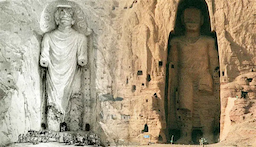
The Bamiyan Buddhas were two colossal statues carved into the cliffs of the Bamiyan Valley in central Afghanistan.
These statues, dating back to the 6th century AD, were once the tallest standing Buddha statues in the world, representing a significant piece of Buddhist art and history. Tragically, they were destroyed in 2001 by the Taliban regime.
- Historical Significance: The Bamiyan Buddhas were carved sometime between the 5th and 7th centuries AD during the flourishing of Gandharan Buddhist art. They stood at a staggering 180 feet and 124 feet tall, depicting a standing male Buddha in the dhyana mudra (meditation posture).
- Destruction: In March 2001, the Taliban, a fundamentalist Islamic group then ruling Afghanistan, ordered the destruction of the Bamiyan Buddhas, labeling them “idols” and an affront to Islamic principles. Despite international condemnation and pleas, the Taliban used explosives and artillery to demolish the statues over a 25-day period.
- Impact and Loss: The destruction of the Bamiyan Buddhas was a devastating loss for humanity. It symbolized the Taliban’s disregard for cultural heritage and their extreme ideology. It also deeply affected the Afghan people, many of whom saw the statues as a source of national pride and a symbol of their history.
- Current Status and Legacy: Today, the empty niches in the cliff face stand as a stark reminder of the destroyed Buddhas. Archaeological efforts are underway to preserve the remaining fragments and document the site. The Bamiyan Valley is now a UNESCO World Heritage Site, and there are ongoing discussions about the possibility of reconstruction.
The destruction of the Bamiyan Buddhas remains a controversial and deeply saddening event. It highlights the importance of protecting cultural heritage and the enduring power of art to transcend time and inspire across cultures.
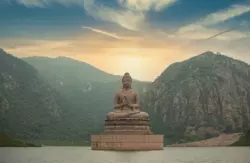
May all beings be happy
May all beings be peaceful
May all beings be safe
May all beings awaken to the light of their true nature
May all beings be free

